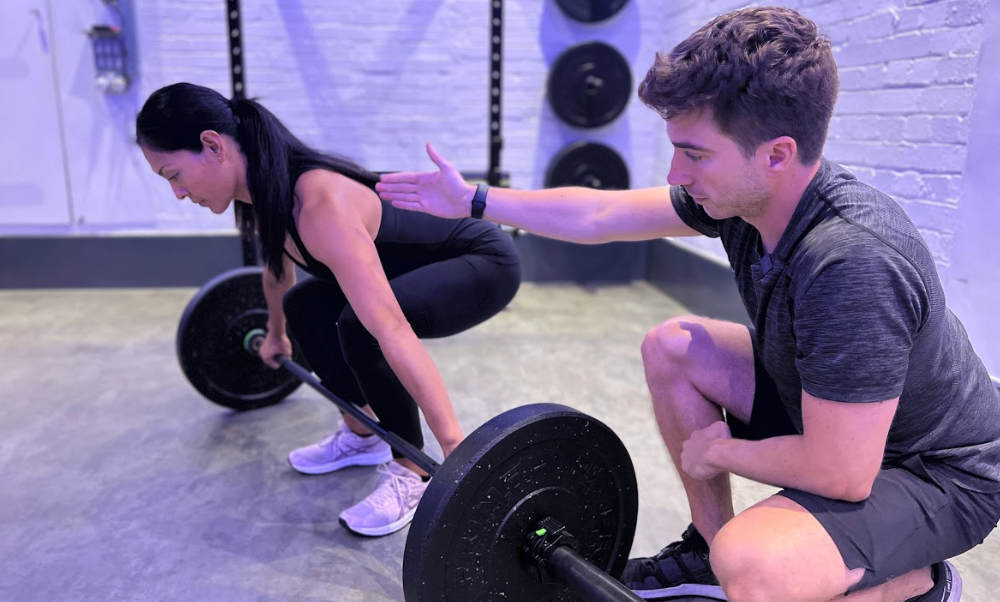This blog is part of our series on the posterior chain. In this blog, we’ll take a detailed look at the best posterior chain exercises for back pain – including lots of the thinking around why strengthening the posterior chain is a positive step.
Why are posterior chain exercises important for people experiencing back pain?
Back pain is an incredibly complex and debated topic within the field of sports science and physiotherapy. Many thinkers have attempted to address the elephant in the room by trying to classify and systemise what back pain points to. In truth, the current literature suggests that back pain, for the most part, rarely results in a specific diagnosis with degrees of certainty.

Just because we don’t exactly know what or why we experience lower back pain, doesn’t mean we can’t manage how it makes us feel – in fact, it points even more to the fact we need specific treatment for specific individuals and their own, specific problems. Pain is a complex, multi-factorial science – trying to explain it is a bit like getting someone to describe what colour the letter twelve smells like.
Still, that doesn’t mean the way we treat back pain has to be as complicated.
One way to modulate or mitigate our experience of back pain is movement, and actually teaching our brains and nervous systems to get used to slow, graded exposure over time. Given the posterior chain refers to the structures at the back of the legs and spine, it makes sense for us to try and get more skilled or stronger in ranges involving these joints and muscle groups: it means, psychosomatically speaking, we don’t feel nervous about loading specific motions or positions.

Whilst we can’t predict injury, lower levels of confidence – and competence – in specific movements are correlated to injury, possibly due to the nervous system responding in a less skilful way at particular end points of a range, resulting in greater likelihood of tears or strains. Or, it could even be a protective mechanism, whereby there’s nothing actually physiologically wrong with your back (which is more often the case); instead, there’s pain signals being sent through your nervous system in an attempt to stay away from the perceived threat or danger, in this instance, an exercise or weight. By working through the glutes, calves, hamstrings and yes, lower back, we develop strength on both physiological and neurological levels. We teach our brains that a deadlift or row won’t suddenly implode our lumbar spine.
Posterior chain exercises are, in a nutshell, a great way of getting stronger and managing back pain – especially in teaching us that exercise isn’t going to make your back feel worse, but rather, improve its conditioning.
Kettlebell B-Stance Deadlift
- With the kettlebell just out in front of you, place one foot in front of the other, the back toe in line with your front heel.
- Lifting the back heel off the ground, hinge from the hips to reach down for the kettlebell, knees nice and soft to help the pelvis move with ease.
- Grab the handle of the kettlebell and slowly, with control, drive the hips forward as the weight comes off the floor.
- Send the hips back again, keeping the kettlebell close to the body and weight in your heels, as you allow it to hover off the floor, pausing before coming back up again.
You can do this with bodyweight to get used to the hinging movement, and even replace the kettlebell with a barbell once you feel strong and confident in the range.
Kettlebell Swings
- Set the kettlebell between your feet, which can be about shoulder-width apart.
- Bend slightly at the knees, then send your hips back until you feel a nice stretch in the back of your legs.
- Grab the handle of the kettlebell and pull it back between your legs to create the momentum needed to swing.
- Drive your hips forward and keep the spine strong and long, sending the weight to around shoulder height.
- Return the weight to the floor and repeat.
Keep the weight a rough five or six out of ten in terms of intensity, and focus on adding in extra reps in order to thoroughly practice the movement.
Bent-over Rows
- Grab a barbell with an overhand grip, hands slightly wider than shoulders.
- With your back straight, bend your upper body by pushing your hips backwards, until the chest is essentially parallel to the ground.
- From this position, row the weight towards your hip crease, so that you really target the entirety of your mid-back region.
This is really easily adjusted: opt for dumbbells if you want to target one side at a time, or use a bench to support your chest whilst you row the weights as usual. This is an excellent exercise to target the entire “back” portion of your anatomy.
Safety First
Remember, the movements and techniques you see demonstrated here are advanced exercises, and our team has practised them countless thousands of times. It’s always a good idea to have professional guidance when you’re exercising – and this is especially true when you’re using free weights.
If you’d like to talk to us about training with us here in London at our Soho, Fitzrovia, or Mayfair studios, we’d love to help. Equally, if you’re somewhere else in the world – we can be by your side virtually using our innovative online training app and video call guidance.

